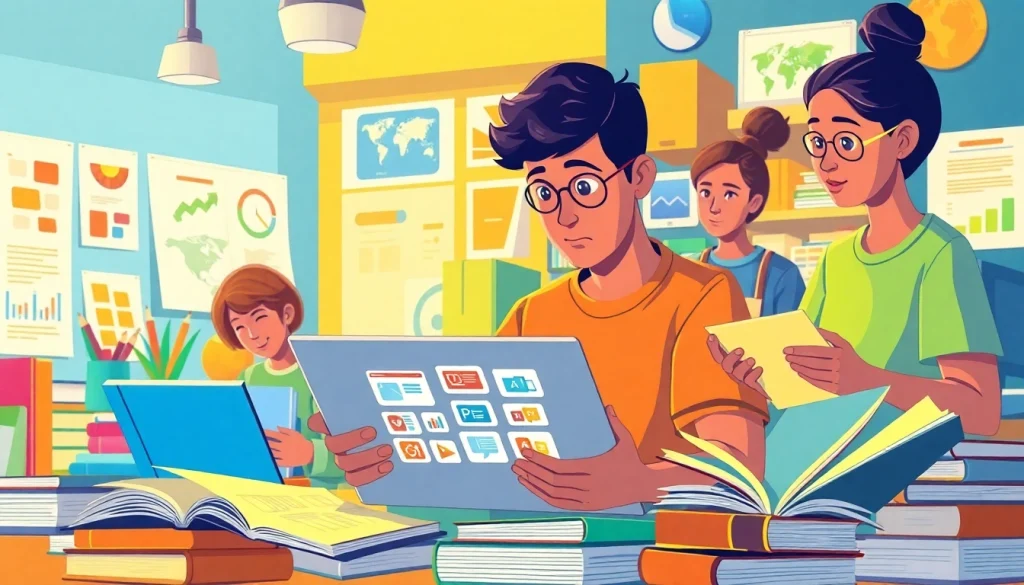
Understanding Educational Resources
What are Educational Resources?
Educational resources encompass a wide range of materials and tools designed to facilitate learning and teaching processes. They can be traditional tools like textbooks and paper worksheets, or more modern approaches such as digital content, videos, and interactive online platforms. Educational resources play a significant role in both formal and informal education. They provide teachers and learners with the means to deliver and acquire knowledge effectively. The evolution of technology has ushered in various forms of educational resources, allowing for an enriched learning experience, often customized to meet individual learner needs.
The Importance of Educational Resources in Learning
The presence of robust educational resources is crucial to creating an effective learning environment. They not only assist in aligning educational goals with teaching practices but also enhance student engagement and retention. Quality resources cater to diverse learning styles, ensuring inclusivity and accessibility. Moreover, they allow educators to diversify their teaching methods, adapt course content for different student needs, and keep up with the latest developments in various fields of study. Examples include initiatives focusing on equitable access to learning opportunities, bolstered by educational resources available online.
Types of Educational Resources Available
Educational resources can be categorized in numerous ways. Common types include:
- Textual Resources: Such as textbooks, journals, articles, and workbooks.
- Digital Resources: Including eBooks, podcasts, and websites that offer interactive content.
- Visual Resources: This category covers videos, infographics, and slideshows which can enhance understanding through visual stimuli.
- Interactive Resources: These involve simulations, quizzes, and gaming elements that engage learners actively.
- Open Educational Resources (OER): These are freely accessible teaching and learning materials that foster collaboration and knowledge sharing.
Exploring Online Educational Resources
Benefits of Online Educational Resources
The rise of the internet has revolutionized the way educational resources are distributed and accessed. The benefits of online educational resources include:
- Accessibility: Learners can access materials anytime and anywhere with an internet connection.
- Cost-Effectiveness: Many resources are available for free or at a reduced cost, removing financial barriers to education.
- Variety of Content: Online platforms host a plethora of formats, catering to diverse interests and learning preferences.
- Interactivity: Many online resources offer interactive elements that can enhance engagement and retention.
- Continuous Updates: Digital content can be easily updated, ensuring learners get the most current information available.
Popular Platforms for Accessing Educational Resources
Numerous platforms provide access to a wealth of educational resources. Some popular ones include:
- Khan Academy: Offers free online courses, lessons, and practice that span a wide range of subjects.
- Coursera: Partners with universities and organizations to offer courses and certificate programs online.
- edX: A platform for high-quality online courses from top universities around the world.
- OpenStax: Provides free, peer-reviewed, openly licensed textbooks, which are available in various subject areas.
- Google Scholar: A freely accessible web search engine that indexes the full text or metadata of scholarly literature across a variety of publishing formats and disciplines.
How to Effectively Use Online Educational Resources
While online educational resources are widely available, using them effectively is essential. Here are some strategies:
- Assess Quality: Not all resources are created equal; evaluate materials for credibility and relevance to your educational goals.
- Utilize Multiple Formats: Combine various types of resources, such as videos, articles, and interactive quizzes, to create a more dynamic learning experience.
- Customize Learning Paths: Tailor your learning journey by picking resources that align with your unique objectives, skills, and interests.
- Seek Feedback: Participate in discussion forums or groups related to your subject to share insights and gain different perspectives.
- Track Progress: Use online learning tools to track your progress and make necessary adjustments to your study plan as you go along.
Creating Custom Educational Resources
Identifying Needs for Custom Educational Resources
Understanding the specific needs of learners is paramount when creating custom educational resources. This process typically involves:
- Needs Assessment: Conduct surveys, interviews, or focus groups to determine what learners require to achieve their educational objectives.
- Contextual Analysis: Examine the environment and conditions in which the educational resources will be used, including any challenges learners might face.
- Defining Implementation Goals: Establish clear objectives for what the educational resources should achieve, ensuring alignment with local educational standards.
Tools to Create Your Own Educational Resources
Modern technology offers various tools to create tailored educational resources, making it easier than ever to cater to specific audiences. Here are some that stands out:
- Canva: Ideal for designing visually appealing educational materials, including posters, infographics, and presentations.
- Google Drive: Offers a suite of tools (Docs, Sheets, Slides) for collaborative creation of documents, spreadsheets, and presentations.
- Articulate 360: This is an all-in-one eLearning authoring tool that helps create responsive courses and training modules.
- Quizlet: Allows educators to create interactive quizzes and study materials that can enhance learning through repetition and engagement.
- Padlet: A virtual bulletin board that can be used to create collaborative educational resources and collect feedback.
Sharing Custom Educational Resources with the Community
Once custom educational resources are created, sharing them with the community can enhance collaborative learning and innovation. Consider these methods:
- Online Platforms: Use websites like OER Commons or GitHub to share educational resources with a broader audience.
- Social Media: Promote resources on platforms like Twitter or Facebook groups that focus on educational topics to reach peers.
- Workshops and Webinars: Host events to present resources and demonstrate their use, encouraging feedback and discussion.
- Collaborative Initiatives: Partner with local educational institutions to distribute resources and train educators on their use.
- Feedback Loops: Encourage community members to provide feedback on the resources, leading to iterative improvements based on collective experiences.
Evaluating the Effectiveness of Educational Resources
Metrics to Measure Educational Resource Impact
Evaluating educational resources is vital to ensure they meet learning goals and improve educational outcomes. Useful metrics include:
- Engagement Rates: Monitor how actively students use the resources through platforms’ analytics.
- Assessment Performance: Compare learner performance before and after using the resources to gauge impact.
- Feedback Surveys: Collect qualitative feedback from users regarding usability and relevance.
- Completion Rates: Track how many learners complete the courses or content provided as this often indicates effectiveness.
- Retention Rates: Observe long-term retention of knowledge among learners who used the resources compared to those who did not.
Feedback Mechanisms for Improvement
Effective feedback mechanisms help refine educational resources over time. Consider these approaches:
- Surveys and Polls: Regularly solicit feedback from users to gather insights on what works and what needs improvement.
- User Testing: Involve learners in testing resources before full implementation to identify usability issues.
- Analysis Tools: Utilize analytics tools to assess user interactions and identify patterns that can inform future iterations.
- Focus Groups: Conduct focus groups to dive deep into user experiences, exploring specific challenges and successes.
- Advisory Committees: Assemble a group of educators and learners to discuss insights and suggest enhancements to educational resources.
Case Studies of Successful Educational Resource Implementations
Case studies provide concrete examples of how effective educational resources can be implemented. For instance:
- Project Based Learning Initiatives: Schools implementing project-based learning often use tailored resources to encourage critical thinking and collaboration, leading to improved student performance.
- Flipped Classroom Models: Educators who flipped their classrooms by using video lectures and interactive resources reported higher engagement and better understanding of subjects.
- Diverse Learning Environments: Schools that adopted OER materials successfully catered to diverse student needs, improving access to quality education for all.
- Community-Led Educational Initiatives: Local groups that shared resources via community workshops have demonstrated enhanced engagement and learning among participants.
Future Trends in Educational Resources
Emerging Technologies in Educational Resources
The future of educational resources will be shaped by emerging technologies such as:
- Artificial Intelligence: AI can personalize learning experiences, adapting content to meet individual learners’ needs and preferences.
- Virtual and Augmented Reality: These technologies can create immersive learning experiences that enhance engagement and retention.
- Adaptive Learning Platforms: These systems use algorithms to adapt educational content in real-time based on user performance.
- Blockchain for Credentials: This technology could verify and share educational credentials securely, promoting greater transparency in academic achievements.
- Gamification: Incorporating game elements into educational resources can make learning more engaging and motivating for students.
The Role of Open Educational Resources (OER)
Open Educational Resources (OER) are transforming the educational landscape by providing free, openly licensed materials for teaching, learning, and research. Their role includes:
- Increasing Accessibility: OER allows learners from diverse backgrounds to access high-quality educational content without financial barriers.
- Fostering Collaboration: Communities can collaborate to create and enhance resources, promoting innovation and shared knowledge.
- Supporting Lifelong Learning: OER supports learners of all ages looking to expand their skills and knowledge.
- Enhancing Curriculum Design: Educators can adapt and modify OER to suit their specific teaching needs and student demographics.
- Promoting Knowledge Sharing: OER can create a culture of sharing best practices and resources among educators and learners.
Innovative Approaches to Educational Resources in Education
Innovative approaches to educational resources will likely focus on enhancing interactivity and adaptability, including:
- Microlearning: Providing bite-sized learning modules that can be easily incorporated into daily routines.
- Social Learning: Utilizing social media platforms to encourage peer-to-peer knowledge sharing and collaboration.
- Project-Based Resources: Developing resources that encourage inquiry, collaboration, and real-world application of knowledge.
- Community-Driven Development: Involving learners in the creation and feedback process to ensure resources are relevant and effective.
- Holistic Integration: Aligning educational resources with mental health and well-being initiatives to support the whole learner.






